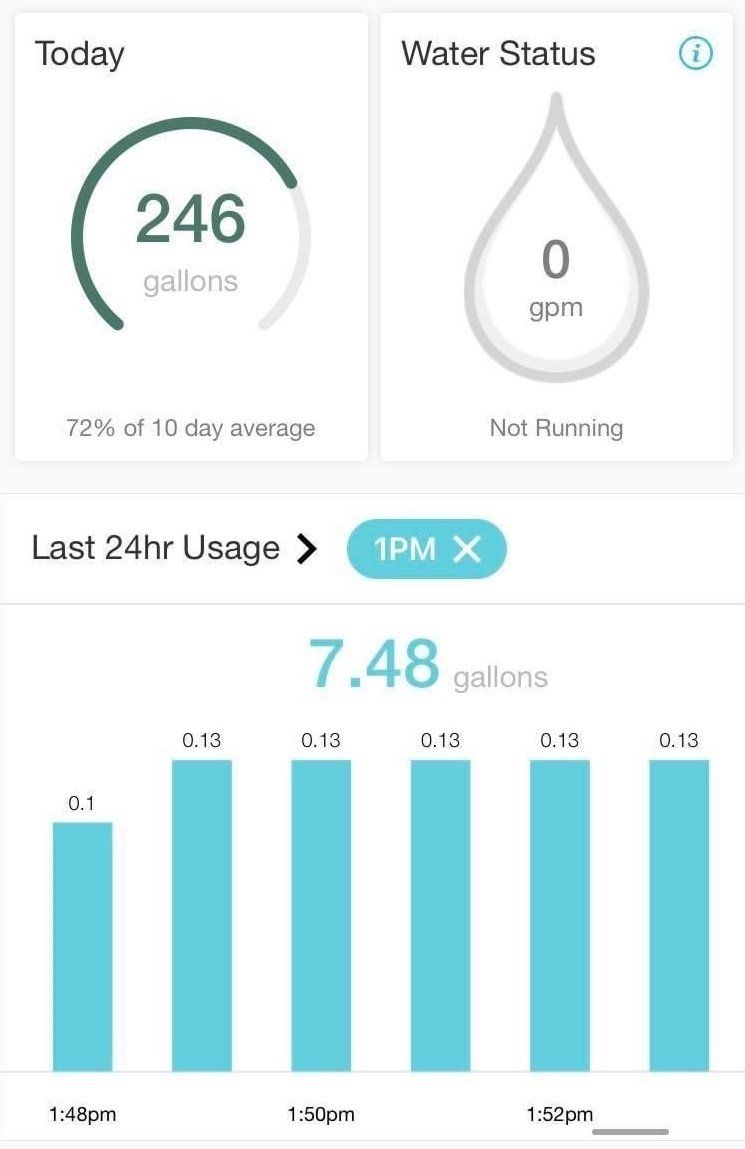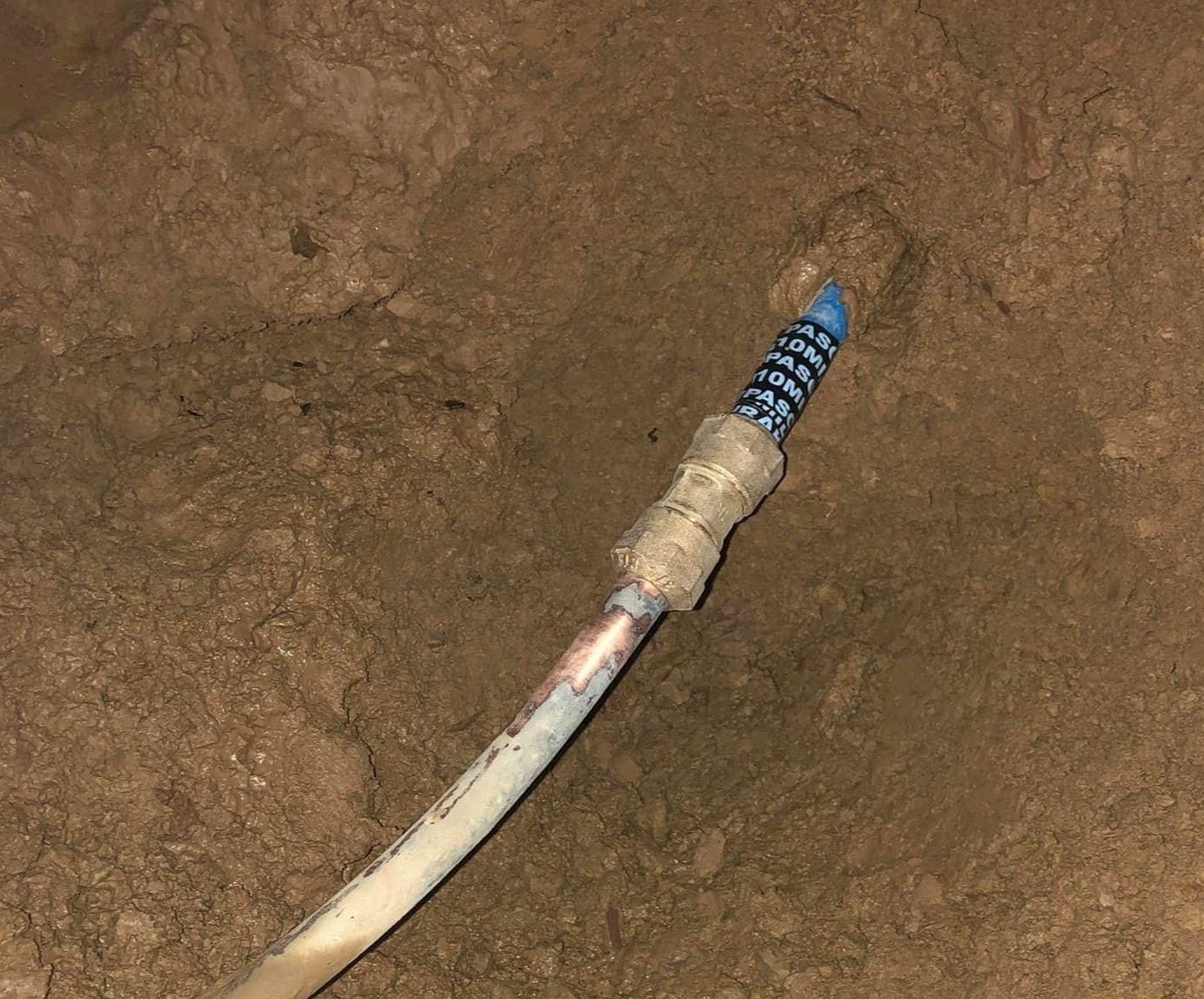Published 11/10/2021: Updated 11/12/2021
Flume Water Monitor and App
Flume is a water flow monitor that clamps to the side of your home’s water meter. By sensing the rotational rate of the flow indicator and knowing what type of meter you have installed, Flume can determine the flow rate. It then transmits that information wirelessly to a gateway device which connects to your home’s Wi-Fi, allowing you to check water usage and receive alerts on your phone.

Flume hardware strapped to the side of my home's culinary water meter
The app keeps track of water usage down to the minute, measuring flow rates as little as 0.01 gallons per minute. It monitors your water spending habits and can alert you to potential water leaks.
I installed a Flume water flow monitor on May 30, 2020. It's great at showing how much culinary water we consume on an hourly, daily, weekly, monthly or yearly basis. It is a novel addition to my interest in data collection and process to improve the efficiency of my home.
On August 21, 2020 at around 10am, a mysterious water leak appeared. Flume started sending me water leak alerts. Water was flowing out of somewhere at the rate of 0.08 gallons per minute. That doesn’t sound like much but left unchecked, adds up to over 3400 gallons per month.


Flume detected this leak that varied from 0.08 gpm to 0.13 gpm
Thanks to the Flume app (and hardware), I would have never known there was a leak. I might have just assumed that the city was ripping me off, or blame the kids for wasting water. How often are we wrong about something and we live out our lives never knowing it?
I looked around the house for evidence of a leaky pipe. Not seeing any wet sheetrock, water on the floor or drips from the ceiling, I figured it was perhaps something leaking in the sprinkler system outside.
I shut off the water to the entire sprinkler system but the leak remained.
I shut off the water to the entire house but the leak still remained.
Opening the lid of the water meter, I noticed a lot of condensation. Could it be leaking near there?
I shut off water at the meter and the leak stopped. This could only mean one thing, the leak was somewhere between the water meter by the street and the shutoff valve in the mechanical room inside the house.
My mind immediately went to that time (over a year ago) when I was working on the rough plumbing down in a trench making the solder connection and how horrible of a job I did at cleaning the copper joint. I was suspicious right away when it started leaking but wasn't ready to go through a lot of effort to determine if this really was the cuprite.
With the hard water in Northern Utah and I have seen on a few occasions where a dripping pin-hole leak will seal itself up after a few days.
This was more than a drip but perhaps it too would seal the leak in a few weeks. While the leak did vary somewhat (between 0.08 gpm and 0.13 gpm), after a couple of months it was still steady as ever, hovering around the 0.11 gpm range.
Doing the math, 0.08 gpm x 60 minutes/hour x 24 hours/day x 30 days/month = 3456 gallons per month.
- A flow rate of 0.11 gpm is 4752 gallons per month.
- A flow rate of 0.13 gpm is 5616 gallons per month.
Now wanting to have thousands of gallons of water needlessly eroding underneath my neighborhood, I decided to get to work and fix the problem.
I dug down a few feet near the water meter but didn’t find any signs of a lot of a multi-thousand gallon/month water leak.
While the water line did run under the driveway, having done the work myself, I had a pretty good idea where the legacy copper line met up to where I connect up with PEX.
I started digging a new hole along the side of the driveway adjacent to where the splice should be. About 2’ down, the soil started getting muddy. I dug down 4’ to the depth of the water line, widening the hole so I could comfortably move around inside.
The deeper I dug, mud got thinner and thinner until the wall of earth under the edge of the driveway burst open and a flood of mud came gushing into the hole in which I was standing. Bingo!! I found it. Or rather it found me.

The main water line properly spliced and ready to be buried back up again
After scooping out a good 30 gallons of sloppy mud with a bucket, I located the water pipe 4 feet down and 2 feet under the driveway. I started to hear the sound of water spraying from the pipe 3 feet under the driveway.
“There you are you little bastard”. I shut off the water supply at the meter and the spraying stopped.
With my teenage son on standby to dig me out if something collapsed, I worked in the short tunnel under the driveway, I spliced in a new section of line (the “right” way this time), sealed it up, turned the water back on and verified the leak stopped.

Flume App showing no more slow leak
Without the Flume app, I would have never discovered this leak. It could have been leaking and wasting water for years before I would have noticed, causing hidden erosion the whole time.
Intermittent Leaks:
Flume has since alerted me to several intermittent leaks, like when the toilet flapper gets stuck and causes the toilet to run water continually. Every one of our toilets has a fatal flaw in the design that sometimes causes the chain to get caught on itself, making itself too short for the flapper to fall back down. I slipped a straw over it making it more rigid. This seems to have helped with the occasional leak problem. Or at least greatly reduced the chances of it happening. When it happens again, Flume will be there to alert me.
Unfortunately we do not have secondary water so we water our garden with culinary water. Flume has been useful at knowing how much water the garden uses.
Irrigation vs Indoor Usage:
While there is only one flow meter, Flume uses an algorithm to predict what water consumption is irrigation and what is indoor usage. Irrigation is typically a high flow rate (Mine is like 8-12 gpm). I do have a dripline zone that averages about 2.4 gpm but it always runs on a schedule and for the same amount of time.
Indoor consumption for my home is rarely above 3-5 gpm.

Flume Showing our Annual and Monthly Water Consumption
Flume plots the irrigation consumption as a darker color. Zooming in on a by-minute scale, Flume is pretty good at knowing when the sprinkler zones kick on and off. Zooming out to a by-month scale (like shown above), it combines total water usage but still displays them by type.
Inside water consumption for our family of 6 averages around 4400 gallons per month.
In 2021, watering the yard and vegetable garden alone has consumed 22,596 gallons, about 4500 gallons per month, doubling our home water consumption during the growing season.
Layton City Residential Water Use Rates (2021)
| Gallons of Culinary Water (w/ access to secondary water) | Water Rate |
|---|---|
| 0 to 6,000 | Base Fee $20.80 |
| between 7000 and 14,000 | $1.85 per 1,000 gallons |
| Over 15,000 | $3.60 per 1,000 gallons |
| Gallons of Culinary Water (No access to secondary water) | Water Rate |
|---|---|
| 0 to 10,000 | Base Fee $20.80 |
| between 11,000 and 25,000 | $1.85 per 1,000 gallons |
| 26,000 - 46,000 | $2.32 per 1,000 gallons |
| 46,000 - 79,000 | $3.23 per 1,000 gallons |
| 80,000 and over | $3.60 per 1,000 gallons |
Except for 1 month during the time we had the slow water leak, we have never consumed more than 10,000 gallons per month. Unless we start consuming more water, our water bill is always going to be just the base rate of $20.80/month.
